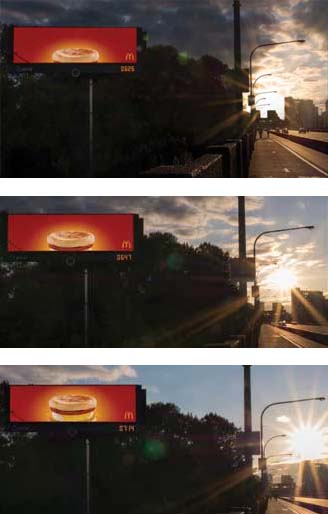Media architecture
For the above reasons, it is important to place any outdoor digital signage strategy within the context of the installation location(s). Europe has taken the lead, both academically and practically speaking, in the field of ‘media architecture,’ with many summits and events dedicated to best practices for integrating digital screens in cities.
The broader purpose of this movement is to make dynamic media a more fundamental part of architectural design, to enhance and enliven communities. In this context, digital signage extends well beyond advertising as an artistic medium, with content closely aligned to the public realm. Generally, these types of projects require extensive expertise in multiple fields, even if they are developed on a relatively small scale.
Monument signs
In many cases, an outdoor digital screen is part of a larger, free-standing monument or pylon sign, serving as a highly visible landmark along a street. One reason for this trend is the esthetic desire to hide or enhance the surrounding ‘box’ and reduce visual clutter.
Another is the opportunity to enhance the digital signage with other dynamic illumination effects to attract attention, though it is important not to allow the lighting to compete directly with the screen. Subtle approaches like cove lighting and ‘washes’ can add pleasant accenting to the monument, while still allowing the screen to be dominant.
Sign systems
Another strategy is to use multiple digital signs for greater messaging effect. In urban areas, a series of outdoor screens can help define a path or gateway.
Emerging technologies
As dynamic, high-resolution imagery becomes more cost-effective for small business owners and other sign shop clients, new technologies have also emerged that lend themselves to the goal of architectural integration.
Smaller screen modules can be interconnected to form flexible and/or creatively shaped displays. This technology can be scaled for installation on everything from guard rails to street furniture.
“People are getting bored with digital screens that just look like another TV,” says Robert Harrington, CEO of Sunrise Systems, which develops LED ticker and transit displays. “Funky shapes and curves are popular today.”
Similarly, the aforementioned OLEDs are enabling screens to be wrapped around building columns.
“OLEDs are thin and can bend more flexibly than any other screen on the market,” Harrington says. “They will revolutionize the way we look at physical environments, where digital elements can be part of any fixtures.”
Craig M. Berger is chair of the visual presentation and exhibition design program at the Fashion Institute of Technology (FIT). This article is based on a series of reports he wrote for the International Sign Association (ISA). For more information and the full reports, visit www.signs.org/research.






